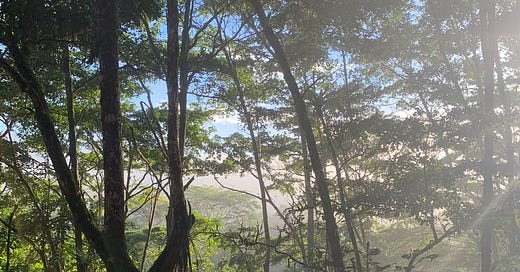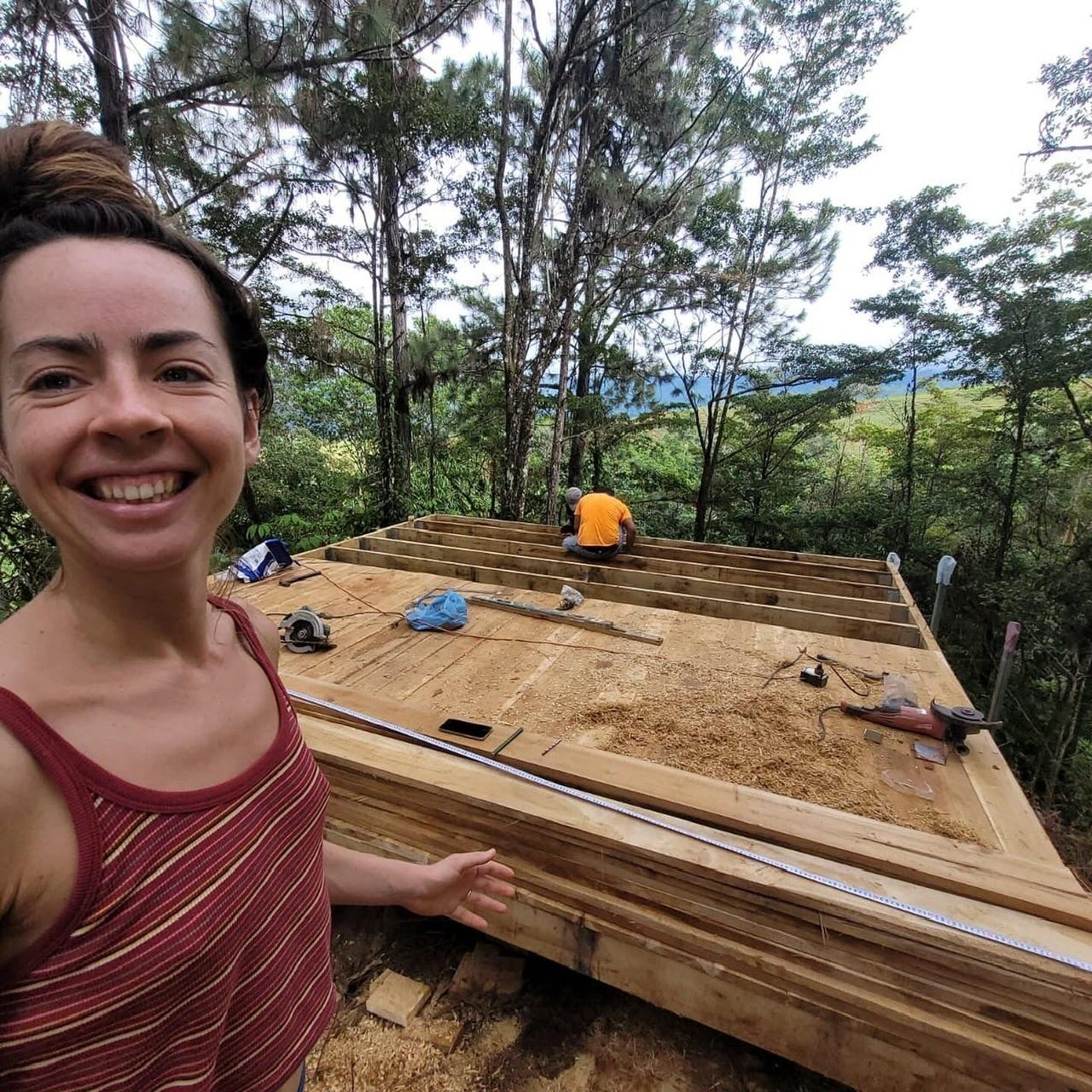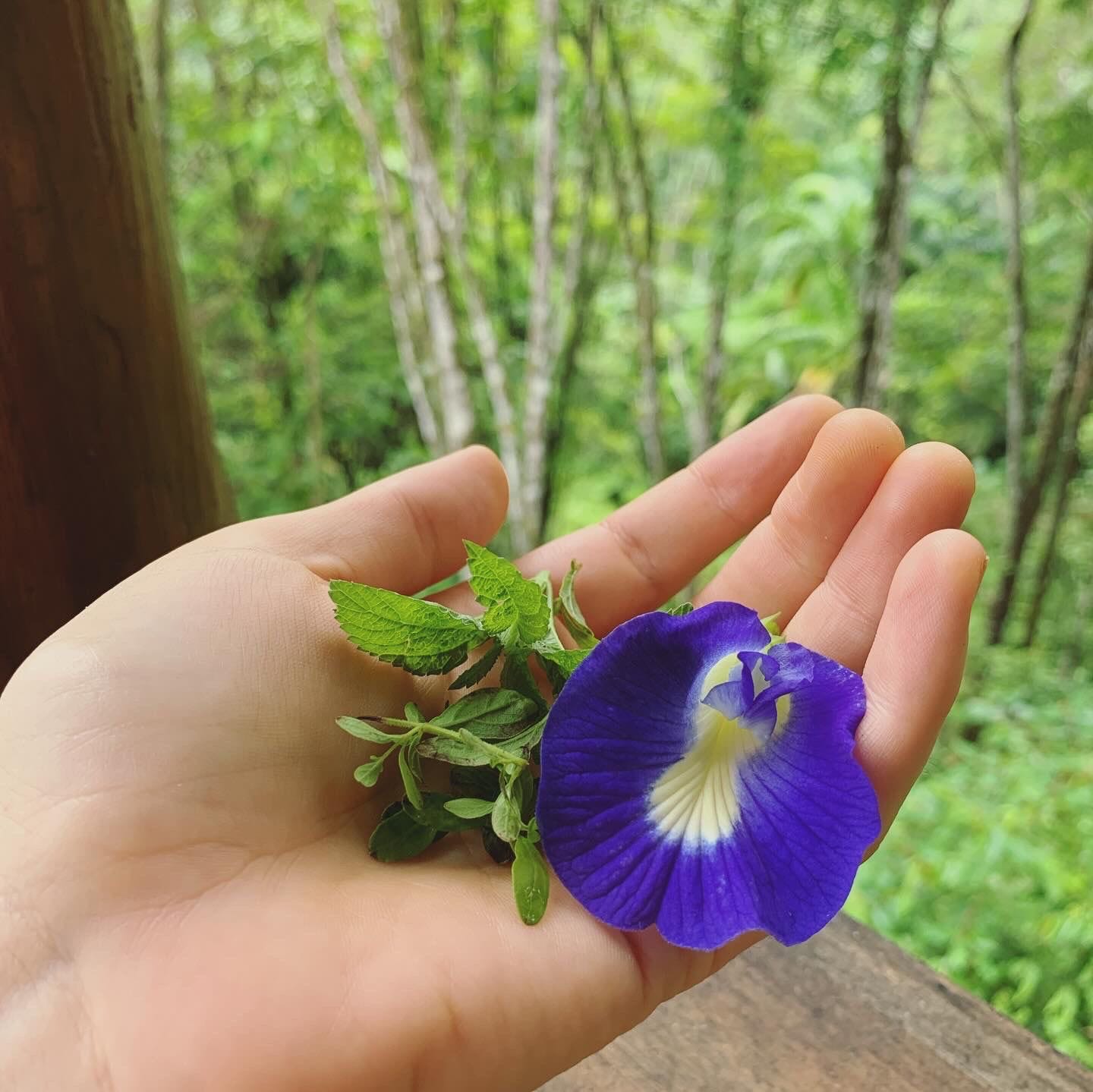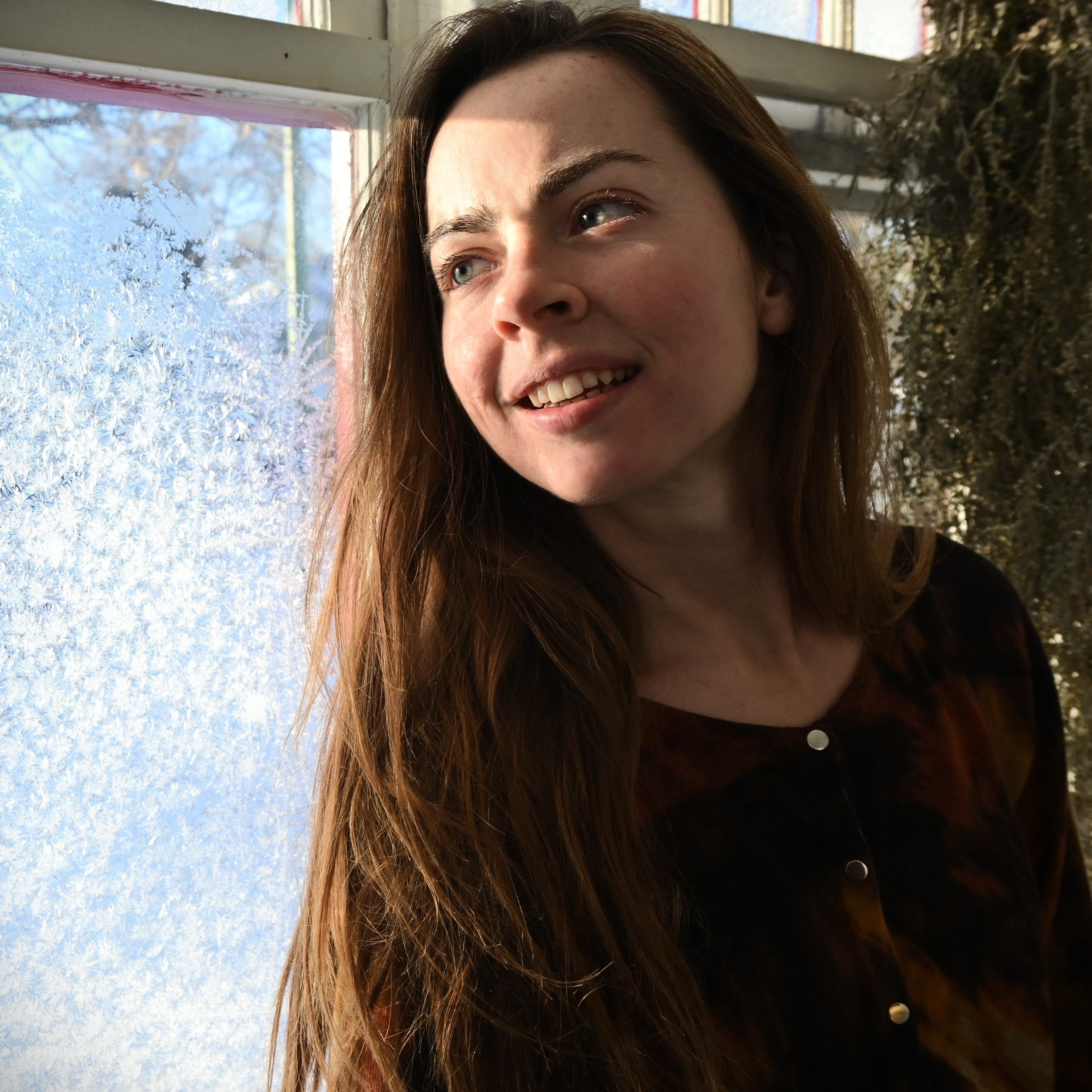Listening to the Body's Wisdom with Cara Amy Goldthorpe
A conversation on healing, creativity, and reconnecting to the wisdom of the natural world with Cara Amy Goldthorpe.
Dear Friends,
I’m excited to introduce the beginning of a long-form interview series on Poetry Outdoors. On the first Sunday of every month, I will be featuring conversations that nourish the soul with special guests who are on a journey of reconnecting & restoring their relationship to the natural world.
Our first guest is Cara Amy Goldthorpe. Cara and I met while out for a hike in the fall of 2022 when her and her husband Alex were visiting from Costa Rica. Alex and my partner Walt had been working in music together and the shared mutual connection sparked an immediate friendship.
They had just purchased a plot of land in the heart of the jungle and we’re beginning their homesteading journey. Since then, Cara and Alex have designed and built their dream jungle sanctuary despite many unexpected surprises along the way like material shortages and heavy wet rainy seasons. They raised an abandoned pup from birth, grown a beautiful garden of medicinal plants, and soon will be expecting their first child.
Cara is a sweet and sensitive soul, deeply attuned to the cycles of nature. She has been on a journey of healing her body from burnout and chronic pain through natural medicine, channeling Earth’s wisdom into her poetry and prose, and sharing her story to help us remember our innate connection to the living world.
Ash Kilback: Tell me about the landscape of the place you grew up in and how it shaped your relationship with nature.
Cara Goldthorpe: I was born in Melbourne, Australia and lived there until I was 18. I grew up as quite an outdoorsy child. I remember telling my parents when I was really young that I wanted to have a rainforest in the backyard.
They were quite into gardening themselves, and gradually the garden evolved to become like that “rainforest” I had yearned for. The plants we had changed over time as summers became drier and we suffered many droughts. However, in all its various forms, the garden was a magnificent biome and ecosystem. I loved the flowers like rhododendrons and camellias we had in the earlier days. When those struggled to bloom due to the changing climate, my new favourites became luscious native plants and especially eucalyptus with its distinctive smell. There are so many different species of eucalyptus - we had one in our front yard with amazing silvery bark that I loved.
The garden was a place you could hide behind old mossy tree stumps and get lost in fantasy worlds. It felt kind of like a fairy forest. It was a really beautiful place where my imagination was sparked. There was also a park near where we lived by the Yarra River where there were lots of Australian eucalyptus trees. It was a wild and rich landscape with lots of species of plants.
My family moved to London when I was 17 and then I joined when I was 18. I started a new chapter of my life in a big city, lived there for many years, before ending up in the jungle in Costa Rica.
AK: When you were young, what drew you to nature and your desire to be connected to the land?
CG: From a very early age, I felt like nature had this Grandmother kind of presence that enveloped me. I had a pretty hard time fitting in at school. I felt like the odd one, the geek, who was bullied and struggled to make friends. When I was in primary school, I remember being able to retreat into nature and find a sense of friendship there. When I felt alone, I still felt held and comforted by nature and inspired by all the beauty around me. I loved to watch the small snails moving on the ground or the different kinds of birds like the Kookaburra. They have a really funny call that sounds like they’re cackling away. I always felt connected when I looked for the beauty around me and it helped me navigate life and any challenges I faced.
AK: You moved from Australia to London, how long were you there? What was the transition like moving from being immersed in nature to a big city?
CG: Event when I lived in Australia, as I got older, I became absorbed in the rat race of academics and school. I still managed to maintain my connection to nature but I had this duality in my life I suppose. When I moved to London it was very much the same. I was both extremely absorbed in my legal studies and then later career, whilst still finding pockets of time to connect with nature in London’s many beautiful parks. I lived there for nearly 9 years.
But I’d be lying if I said I got the balance right. I did end up burning out and experiencing a total health crisis. I spent so much time working and in isolation from everything that’s not natural, that goes against the rhythms of how we’re supposed to live, in harmony with nature. I experienced a lot of duality in London. It was both the place where I totally lost myself and found myself again. Having a health crisis forced me to reconnect with my essence and nurture myself.
I've noticed during my time in Costa Rica where there is such an abundance of nature, it is so easy to connect. But at the same time it’s been a challenging transition where I’ve had moments getting caught up in the struggle to survive or to achieve my dreams/be in entrepreneurial mode. So I’ve also experienced disconnection from nature despite being in a place where I can easily be so immersed. I realize that no matter where we live, we still consciously have to choose to carve out time, to make sure we don't lose touch. Even in the most beautiful of places, we can have the same struggles.
AK: Yes, I think you’ve touched on something that many people are experiencing right now. We’re so caught up in the spiral of doing (striving, chasing, achieving) that collectively, we’re exhausting ourselves to the point of chronic illness. What was your experience with burnout like and how did you heal from it?
CG: The first time I experienced it was in London during the middle of my legal studies. I ended up in the emergency room with a stomach illness that left me unconscious. It wasn’t just that incident which was the problem, but the symptoms that came after it - inflammation, chronic pain, fatigue, blackouts and dizziness. It was endless and I wasn’t able to do much of anything. There was a time when my fatigue was so intense that I couldn’t get out of bed, but I wasn’t getting answers or a diagnosis from doctors. It was one of those humbling moments that brings you to your knees in life and I thought, I don’t have anything if I don’t have my health. But I spent a lot of time in a spiral of pain and depression before I was able to get better.
During one of my lowest points, I ended up going on a summer holiday to Corfu, Greece with my partner at the time. One night, I heard the sound of tribal drums coming from an olive grove up in the hills. I was fascinated by the sound. The next day, I convinced my partner to go see what was going on. We drove up the hill on this little bike and discovered it was a spiritual festival. We ended up getting tickets for a concert happening the next night.
The concert was on top of a hill overlooking the Mediterranean. The most magical setting. Everyone was gathered around this ancient olive tree listening to Estas Tonne play the guitar, pulling us into a meditative trance. I noticed people starting to dance and soon my entire body was consumed by this energy to get up and dance too. I started shaking and moving my body in this freeform way I never had before. I was ecstatic, it felt like there was electricity pulsing through my veins and for the first time in months, I didn’t feel pain in my body as I entered a trance-like state of bliss.
When we got back home to London, I knew I needed to find a way to rediscover that feeling I had experienced in my body while dancing, the mental distance from my pain where I could see the possibility of getting better instead of being totally absorbed in it. That sparked my journey of exploring holistic wellness.
AK: That’s beautiful. To me, I hear that you started to come back to the natural intelligence of your own body, to see the body itself as its own ecosystem. What did you begin to learn from your body by healing from this place of awareness?
CG: I think the body is always going to do what it needs to do in order to be heard. If we ignore the little things, we’ll be hit with something big like a major health crisis. That’s the body’s way of giving us a chance to come back into balance instead of suddenly just literally dying one day.
I started to see my illness as a chance I was given to reconnect and bring myself back into balance. My body shutting down forced me to focus on healing and I learned to see how the body is constantly communicating even when we're not well, and to not view those moments of disease as being bad. They’re serving us, as a chapter in our lives. If we observe nature, we can witness how it goes through phases and cycles. Right now, we’re transitioning into the winter season. Things are dying, but there is going to be this rebirth and renewal.
Now in a similar way, the body has the remarkable ability to renew itself. In a healthy body, cells are still dying and new ones are being generated. But if we push our body too far, that’s when illness happens, when things get out of balance and the cycle isn’t natural. The body will always be sending us signs and signals for what it needs to be in its harmonious rhythms. The more we can tune into that wisdom, the more we can start to pick up on any signs of disharmony - so that we don’t experience a major burnout or other health crisis.
Our body is not the enemy, and I think often in society, we’ve been made to judge and dismiss it and hurry up its process. Even a lot of natural medicine can be “unnatural” if it’s used to mask a symptom as opposed to addressing root causes. A herb that’s always used as a crutch for a prolonged period of time can be just like a pharmaceutical pill - and even have its negative side effects.
I’ve learnt that the more we force our bodies into healing, the more disconnected we become longer term. And if we think of animals in the wild, when they’re injured or sick, they will just go burrow somewhere to rest and fast until they heal. I’m not saying we need to all go burrow away in the woods and not eat anything (laughs) or ever take medicine, but when we look at nature's own process, we can learn a lot about healing our own bodies and being patient with the journey.
AK: What are the small, practical ways that we can learn to come back into conversation with our bodies?
CG: The biggest thing that helped me was active meditations, practices that would bring me into my body through movement. We spend so much time in our heads living mental lives. We come home after the end of a busy work day, sitting at our desk, and then try to sit cross legged and meditate and that’s not what we need.
It’s not going to connect us to our body because we’ve been sitting our whole day. When you look at ancient cultures, people lived active lifestyles working the land where they’d be very much in their bodies all day and then could come home and meditate by sitting in silence. What most of us need in a modern society where we don’t do so much physical movement, is to move our bodies. Movement practices that have conscious and meditative elements to them are so valuable to help us recalibrate.
One simple practice a person can do is to stand, put your feet in shoulder width position, and just freely shake your body. It’s a powerful practice that helps unlock tension. We also hold a lot of trauma in our bodies and when we start to move that energy, we release it.
AK: This brings to mind our creativity as an embodied experience also. When we come back into conversation with our body, how does this support our ability to be creative?
CG: As humans we have both a creative and a logical side to ourselves. When we’re too logical, we experience blocks in our creativity. How many times have you sat down and thought, Okay it’s time to write now, but just stared at the blank screen with the words not flowing. This happens when we are disconnected from our bodies and too much in our head.
In esoteric traditions, the creative energy comes from the base of our spine, our Kundalini, our life force energy. It's also connected to our sexuality. Creativity is of the body, it’s a primal thing. The more we are in our body, the more we unlock that source of energy, right? That’s how we know we’re really in our creative flow, when we’re not thinking from our logical side.
We might write something in creative flow and then later edit and refine it with our logical side. That’s beautiful because we are beings with these two halves. I think we need both, but to first connect with our primal, unaltered side, the side that isn’t seeking perfection and refinement, so we can allow our creative energy to flow freely.
AK: I love the way you describe creativity as an innate, primal force. I think for many of us when we show up to the page to write, we’re immediately in our minds more than our bodies. It’s hard to get outside of the mind and let the body speak first.
CG: Yes, we all have these inhibitors like procrastination, perfectionism or doubt. As an artist, I’ve struggled with perfectionism and striving for certain ideals which have blocked me from sharing anything because I feel it needs to be perfect.
It makes me think of how we’ve been taught creativity in school. In English class, we learned about writing through literacy devices like similes, metaphors, and alliteration. But how many great writers through history sat down to write thinking they were going to write a poem and use alliteration three times? I don’t think they did that, so we have a lot of unlearning to do about how we were taught to approach creativity.
It’s not necessarily that we’ve been taught the wrong things, it’s more about what we put emphasis on when we create. Think of the theory of The Big Bang — an explosion creating life and the universe that was messy and wild. That’s how we can think of showing up on the page, letting the untamed, unaltered and raw part of ourselves be expressed and then later coming back to refine and edit our work.
Damiana Blooms
Oh, she lasts, as long as the sun
delicate in her tender bloom
yet fierce as a blazing summer's day
she rides the waves come what may
a tonic to balance, the insane mind
yet what is sanity anyway?We do our best in a broken world
finding beauty amidst the wars
while she opens and she closes
as the light does fade
a reminder to savour each breath
or you'll be gone, before you know
swept up in the flow
without truly feeling the hearth
of your heart.
So - tend those fires
blaze with passion, desire
create art and sing songs to the stars
and speak to the plants
ask their wisdom, feel their words
whispering from where only Spirit goes.
- Cara Amy Goldthorpe
AK: Nature is an overarching theme in your writing. How does the practice of getting out into the world help us with our creativity?
CG: Nature is very spontaneous and creative. It’s not caught in its logical mind. It just does things. A flower opens and it’s not thinking about how it's going to open. What I found is the more connected I am to nature, the more I get out there and observe the beauty and the way nature does its thing without thinking about it, it allows for greater presence and a more embodied approach to life. Witnessing nature can help us reconnect to the beauty that’s inherent as opposed to the beauty that’s of the logical mind.
AK: What does your creative journey look like now?
CG: Messy and all-encompassing is probably the best way to describe it. I feel creativity permeating all aspects of my life as I seek to live more and more in my own natural flow. In terms of my writing, I do it often yet find it comes in somewhat sporadic gasps interwoven through my busy daily living. I’m also seeking to incorporate more of my knowledge on holistic health into my creative work, to share what I’ve learned from my personal experiences as well as studies, but in a way which is less dogmatic. I find there’s a lot of dogma and too many “gurus” in the modern spiritual scene. I want to help others by supporting them to connect to their own inner wisdom and power.
My life is getting busier, as I’m racing towards upcoming big transitions — I’m in my second trimester of pregnancy and we are putting the finishing touches on our home, and working while I still can. I notice I have less time to think and fret about perfection, and I’m forced to be more in free-flow with life circumstances. And somehow, despite new life and financial stressors and a lot of bodily change, things are feeling more natural and creative than ever before.
I plan to keep writing and sharing my work throughout these new chapters, but I’m trying to stay open as to how my writing will evolve alongside everything else. I certainly don’t see my life as “perfect”, and it has its rollercoasters and challenges, but everything is teaching me to surrender more to the currents and I’m excited for what’s to come.
Cara Amy Goldthorpe is a storyteller, poet, and holistic health practitioner, as well as one half of the musical duo "Flett & Goldthorpe" alongside her husband. She is the author of the fantasy novel Siege and two collections of poetry, Wildfire and Love Letters in the Ether.
She has also studied a variety of healing modalities including traditional Mayan medicine & herbalism, and Craniosacral therapy. She is an ongoing student of Hung Gar Kung Fu, deriving from the Shaolin temple in Southern China and incorporating philosophy and principles of traditional Chinese medicine and energy healing. Cara is passionate about health, wellbeing and the arts. Through her creative work, she hopes to inspire people to live more in connection with themselves, each other, and the world around.










